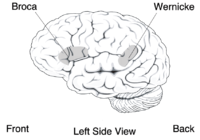
Photo from wikipedia
BACKGROUND This study examined speech (hypernasality and intelligibility), language, and reading skills in children with a cleft palate, specifically investigating additional conditions to the cleft, in order to differentiate challenges… Click to show full abstract
BACKGROUND This study examined speech (hypernasality and intelligibility), language, and reading skills in children with a cleft palate, specifically investigating additional conditions to the cleft, in order to differentiate challenges related to a cleft only, and challenges associated with an additional condition. DESIGN Cross-sectional data collected during routine assessments of speech and language in a centralised treatment setting. PARTICIPANTS Children born with cleft with palatal involvement from four birth cohorts (n=184), aged 10. OUTCOME MEASURES Speech: SVANTE-N; Language: Language 6-16; Reading: Word Chain Test and Reading Comprehension Test. RESULTS Descriptive analyses revealed that 123 of the children had a cleft only (66.8%), while 61 children (33.2%) had a cleft that was associated with an additional condition (syndrome, developmental difficulty, attentional difficulties). Due to close associations with the outcome variables, children with specific language impairments and dyslexia were excluded from the sample (n=14). In the total cleft sample, 33.1% had mild to severe hypernasality, and 27.9% had mild to severe intelligibility deviances. Most children with intelligibility and hypernasality scores within the normal range had a cleft without any other condition. A high number of children with developmental difficulties (63.2%) or AD/HD (45.5%) had problems with intelligibility. Hypernasality scores were also associated with developmental difficulties (58.8%), whereas most children with AD/HD had normal hypernasality scores (83.3%). As could be expected, results demonstrated that children with a cleft and an additional condition had language and reading scores below average. Children with a cleft only had language and reading scores within the normal range. Among the children with scores below average, 33.3-44.7% had no other conditions explaining difficulties with language and reading. CONCLUSIONS The findings highlight the need for routine assessments of language and reading skills, in addition to assessments of speech, in children with a cleft, in order to identify potential problems as early as possible. Study designs need to take additional difficulties into account, so that potential problems with language and reading are not ascribed the cleft diagnosis, and can be followed by appropriate treatment and interventions.
Journal Title: Journal of communication disorders
Year Published: 2017
Link to full text (if available)
Share on Social Media: Sign Up to like & get
recommendations!